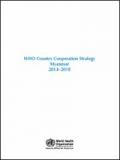What's New
Displaying results 3151 - 3160 of 4914

Resource | Presentations,
A compilation of the epidemiology data and graphics contained in the Gap report on people living with HIV.

Resource | Presentations,
A compilation of the epidemiology data and graphics contained in the Gap report on people who inject drugs.

Resource | Presentations,
A compilation of the epidemiology data and graphics contained in the Gap report on people with disabilities.

Resource | Presentations,
A compilation of the epidemiology data and graphics contained in the Gap report on prisoners.

Resource | Presentations,
A compilation of the epidemiology data and graphics contained in the Gap report on sex workers.

Resource | Presentations,
A compilation of the epidemiology data and graphics contained in the Gap report on transgender people.

Resource | Presentations,
11th Regional Management Meeting,
UNAIDS Regional Support Team for Asia and the Pacific 25 October 2014, Bangkok

Resource | Guidelines,
HIV is now a treatable condition and the majority of people who have HIV remain fit and well on treatment. Despite this, a significant number of people are unaware of their HIV infection and remain at risk to their own health and of unknowingly passing their virus on to others. Late diagnosis is the most important factor associated with HIV related morbidity and mortality. Patients should therefore be offered and encouraged to accept HIV testing in a wider range of settings.
The new guidelines will provide flexibility and versatility for all healthcare providers and accommodate the decentralized approach being undertaken by the National AIDS Programme (NAP).

Resource | Publications,
The World Health Organization (WHO) Country Cooperation Strategy (CCS) 2014–2018 for Myanmar provides a coherent medium-term vision of WHO’s technical cooperation, and defines its strategic framework for working in and with the country. It aligns closely with the priorities of the National Health Policy, Strategies and Plans and is harmonized with efforts of the United Nations (UN) system for country development. The present CCS is built on the experience and achievements of the previous CCS 2008–2011 and takes into consideration the emerging country situation. It also follows the guidance of Twelfth General Programme of Work (GPW), which provides a six-year (2014–2019) vision for the Organization. GPWs set a global health agenda for all stakeholders and establish a strategic, results-based and accountable framework for WHO. The Twelfth GPW comprises five, as opposed to a previous 13, programmatic categories and one administrative category.






